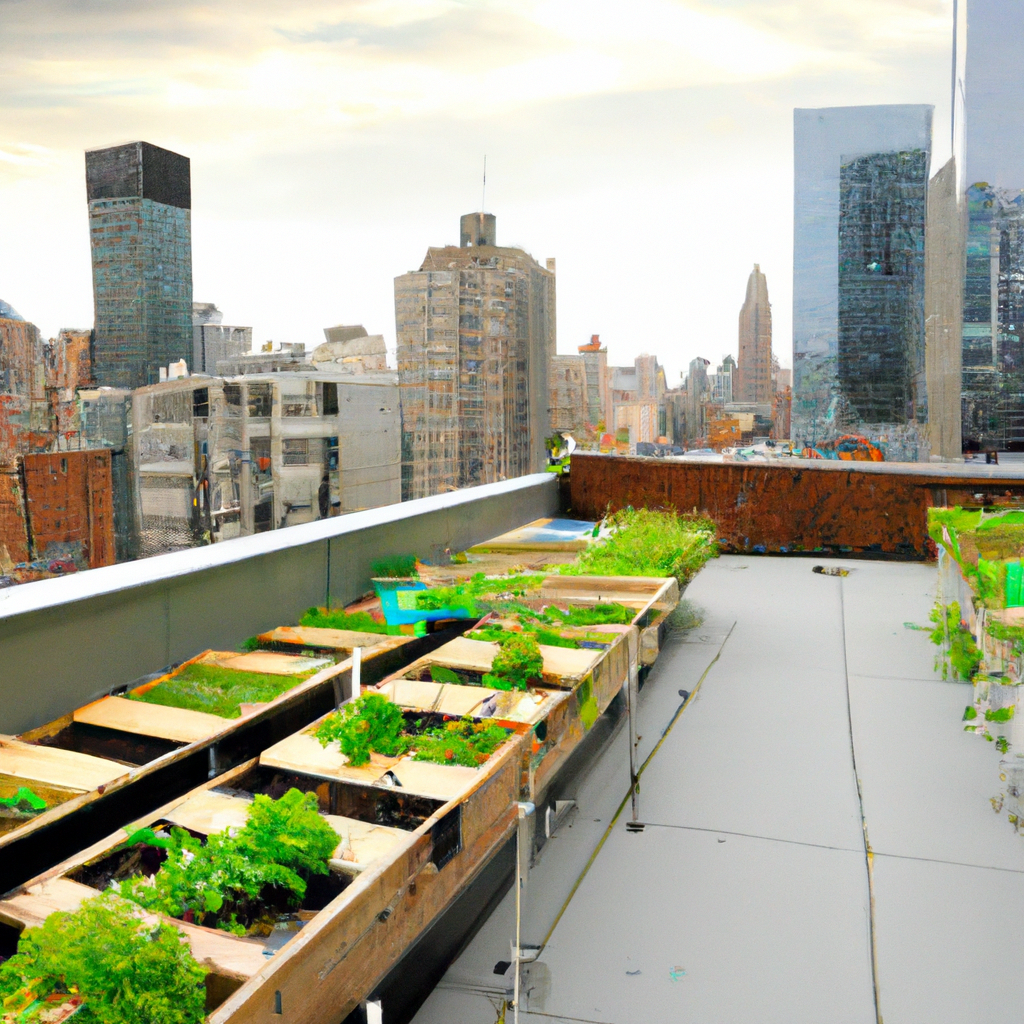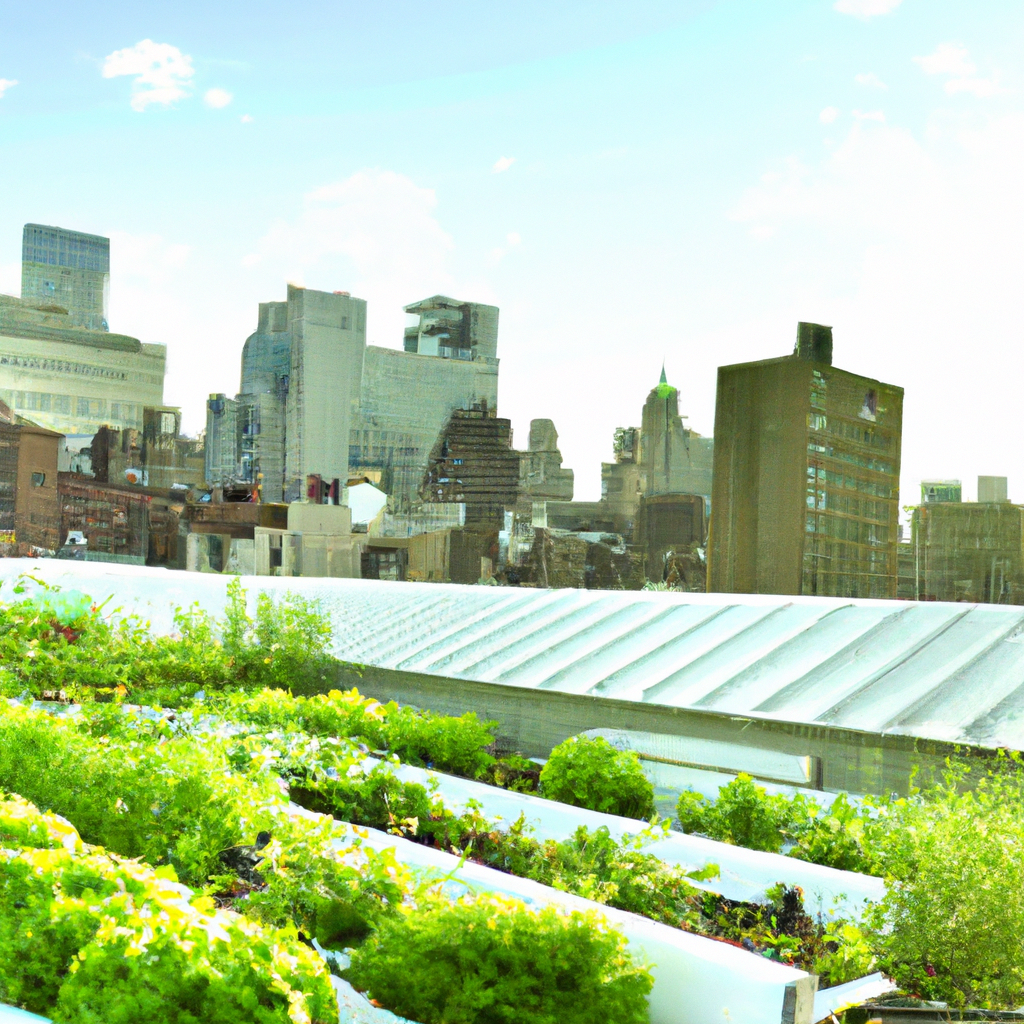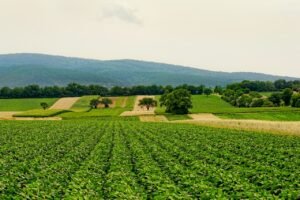
Imagine a cityscape where skyscrapers are adorned with lush green landscapes, where the concrete jungle is transformed into a vibrant and sustainable oasis. This is the future of urban agriculture, where rooftop farms have emerged as a promising solution to the challenges of food production in densely populated areas. With limited land space, rising demand for local produce, and increasing concerns about food security and sustainability, rooftop farms offer an innovative and practical approach to urban farming. These elevated gardens not only provide fresh, organic food but also contribute to improved air quality, reduce urban heat island effect, and foster a stronger sense of community. The future is growing upwards, quite literally, as more cities embrace the transformative potential of rooftop farms to reshape the way we cultivate and consume food in urban environments.

Benefits of Rooftop Farms
Reduced Food Miles
One of the key benefits of rooftop farms is the reduction in food miles. With traditional farming methods, produce often needs to travel long distances to reach the consumer. This results in increased carbon emissions from transportation and a loss of freshness. However, rooftop farms located in urban areas can significantly reduce these food miles since the produce is grown right where it is consumed. This not only reduces carbon emissions but also ensures that the food is fresher and healthier for the consumer.
Improved Air Quality
Rooftop farms play a significant role in improving air quality in urban areas. Plants absorb carbon dioxide and release oxygen through photosynthesis, helping to reduce greenhouse gas emissions. By converting unused rooftop spaces into farms, this process is enhanced as more plants are introduced into the urban environment. Additionally, rooftop farms also act as natural air filters, trapping dust and pollutants in the air and improving overall air quality for nearby residents.
Stormwater Management
Urban areas often face challenges with stormwater management, leading to issues such as flooding and water pollution. Rooftop farms offer a solution to this problem by acting as green infrastructure. The plants and soil on these farms can absorb and retain rainwater, slowing down the rate at which it enters the stormwater system. This helps to alleviate pressure on the drainage system and reduces the risk of flooding. By incorporating green roofs into urban design, cities can effectively manage stormwater while also benefiting from the agricultural productivity of rooftop farms.
Enhanced Urban Biodiversity
The presence of rooftop farms in urban areas also promotes enhanced urban biodiversity. These green spaces attract a variety of pollinators such as bees and butterflies, creating a more diverse ecosystem. Additionally, rooftop farms can also provide a habitat for other wildlife, including birds and insects. This increased biodiversity contributes to the overall health and sustainability of urban environments, creating a more balanced and resilient ecosystem.
Challenges for Rooftop Farms
Limited Space
One of the main challenges for rooftop farms is the limited space available. In densely populated cities, finding suitable rooftop areas for farming can be a challenge. However, creative solutions such as vertical farming and hydroponics systems have emerged to maximize the use of limited space. These innovative techniques allow for the cultivation of crops in a vertical manner, utilizing the height of buildings to increase the farming area.
Structural Considerations
Another challenge that rooftop farms face is structural considerations. Not all rooftops are designed to support the weight of a farm, especially those in older buildings. Before implementing a rooftop farming project, careful assessment of the structural integrity of the building is necessary. This may require modifications to ensure that the rooftop can safely support the weight of the soil, plants, and irrigation systems. Collaboration between architects, engineers, and farmers is essential to ensure the feasibility and safety of rooftop farming structures.
Access to Water and Electricity
Rooftop farms require a reliable and sufficient water supply, as well as access to electricity for irrigation and lighting systems. In urban areas, water scarcity can be a challenge, and finding sustainable water sources for farming becomes crucial. Additionally, accessing electricity may also be limited or expensive, especially for older buildings. However, advancements in water harvesting techniques and solar-powered systems provide solutions to these challenges, making rooftop farms more sustainable and self-sufficient.
Managing Pests and Disease
Like any agricultural undertaking, rooftop farms are susceptible to pests and diseases. However, since these farms are located in urban environments, they may face unique challenges in managing these issues. The proximity to other buildings and potential contamination from pollutants can increase the risk of pests and diseases. Integrated pest management (IPM) techniques, such as biological controls and crop rotation, can help mitigate these risks. Implementing proper sanitation practices and regular monitoring also play a crucial role in maintaining the health of rooftop farms.

Innovative Technologies for Rooftop Farms
Hydroponics and Aeroponics Systems
Hydroponics and aeroponics systems are innovative techniques that allow plants to grow without soil, using nutrient-rich water and mist, respectively. These systems are well-suited for rooftop farms as they require less space and water compared to traditional farming methods. Hydroponics and aeroponics maximize the use of vertical space, making them ideal for urban environments with limited land availability. These technologies also provide precise control over nutrient delivery, resulting in higher crop yields and faster growth rates.
Vertical Farming Solutions
Vertical farming is a revolutionary approach to crop cultivation that involves stacking plants vertically in layers or racks. This method allows for a significant increase in the farming area while minimizing the space required. Vertical farming systems utilize artificial lighting and controlled environments, enabling year-round cultivation of crops. This technology is particularly advantageous for rooftop farms, as it maximizes the use of limited space while reducing the need for extensive land resources.
Greenhouse Technologies
Greenhouse technologies have long been used in agricultural practices, and they are also highly compatible with rooftop farming. Greenhouses create controlled environments that protect crops from external conditions, such as extreme temperatures and pests. By capturing and maximizing sunlight, greenhouses provide an ideal climate for plants to thrive. Additionally, incorporating renewable energy sources, such as solar panels, can further enhance the sustainability of greenhouse rooftop farms.
Solar-powered Farming Systems
Solar-powered farming systems combine the benefits of renewable energy with agricultural practices. By harnessing solar energy to power irrigation systems, lighting, and other farm operations, rooftop farms can become more sustainable and reduce their carbon footprint. Solar panels can be installed on rooftops, effectively utilizing unused space for both energy generation and farming. Furthermore, advances in battery storage technology allow for efficient energy storage, ensuring uninterrupted power supply even during cloudy days or at night.
Urban Farming Policies and Regulations
Zoning Regulations
Zoning regulations play a critical role in determining where and how rooftop farms can operate in urban areas. Cities need to establish suitable zoning classifications that recognize rooftop farming as a legitimate land use. This involves designating specific areas or zones for agricultural purposes and defining the guidelines for constructing and operating rooftop farms. Clear and supportive zoning regulations can encourage the integration of rooftop farms into urban planning and facilitate their growth.
Permit Requirements
Rooftop farming projects often require permits from local authorities to ensure compliance with safety, building, and environmental regulations. Permit requirements may vary depending on the jurisdiction, but typically cover aspects such as structural engineering, water management, electrical installations, and waste management. Streamlining the permit application process and providing clear guidelines can expedite rooftop farming projects, making it easier for farmers to establish and operate their farms.
Incentives for Rooftop Farming
To encourage the development of rooftop farms, cities can implement various incentives for farmers and building owners. These incentives may include tax breaks, subsidies, or grants for investment in rooftop farming infrastructure. Cities can also offer reduced utility rates for water and electricity to offset operational costs. By providing financial support and incentives, policymakers can spur the growth of rooftop farms and help create a more sustainable and resilient urban food system.
Collaborations between Government and Private Sector
Collaborations between government entities and the private sector are essential for the success of rooftop farming initiatives. Governments can work with farmers and organizations to develop programs, provide funding, and offer technical expertise. The private sector, including building owners and developers, can partner with farmers to provide access to suitable rooftop spaces and invest in the necessary infrastructure. Collaborative efforts ensure effective coordination, maximize resources, and promote the long-term viability of rooftop farming projects.

Successful Rooftop Farming Projects
Brooklyn Grange in New York City
Brooklyn Grange is one of the most well-known and successful rooftop farming projects in New York City. With two rooftop farms totaling over 2.5 acres, Brooklyn Grange produces a wide range of vegetables and herbs. The farms utilize rooftop spaces in Brooklyn and Queens, maximizing the use of limited urban land. Brooklyn Grange not only provides fresh, organic produce to local communities but also offers educational programs and community events, fostering a connection between urban residents and their food sources.
Lufa Farms in Montreal
Lufa Farms in Montreal has pioneered the concept of commercial rooftop farming on a large scale. This innovative project operates multiple rooftop greenhouses across the city, producing a variety of fresh vegetables year-round. Lufa Farms utilizes hydroponic systems and advanced technologies to optimize crop growth and maximize yields. The company also offers a subscription-based model, providing customers with weekly deliveries of locally grown produce. Lufa Farms demonstrates the economic viability of rooftop farming while meeting the increasing demand for local, sustainable food.
Gotham Greens in Chicago
Gotham Greens is an urban agriculture company that has successfully implemented rooftop farming in Chicago. With more than 10 years of experience, Gotham Greens has established several large-scale rooftop greenhouses within the city. These farms produce a significant quantity of leafy greens and herbs throughout the year, supplying local grocery stores and restaurants. By integrating advanced greenhouse technologies and sustainable practices, Gotham Greens exemplifies the potential of rooftop farming to support the urban food system.
Lufa Farms in Montreal
Lufa Farms in Montreal has pioneered the concept of commercial rooftop farming on a large scale. This innovative project operates multiple rooftop greenhouses across the city, producing a variety of fresh vegetables year-round. Lufa Farms utilizes hydroponic systems and advanced technologies to optimize crop growth and maximize yields. The company also offers a subscription-based model, providing customers with weekly deliveries of locally grown produce. Lufa Farms demonstrates the economic viability of rooftop farming while meeting the increasing demand for local, sustainable food.
Economic Viability of Rooftop Farming
Reduced Operating Costs
Rooftop farms can benefit from reduced operating costs compared to traditional farming methods. By utilizing underutilized urban spaces, farmers can avoid the high costs associated with acquiring land in rural areas. Rooftop farms also require less water than conventional farming, reducing water expenses. Additionally, by using innovative technologies such as hydroponics and aeroponics, farmers can achieve higher crop yields in a smaller farming area, maximizing efficiency and lowering production costs.
Local Market Opportunities
Rooftop farms offer unique opportunities to capitalize on the growing demand for locally sourced and sustainably grown produce. By being located within urban areas, these farms can directly supply fresh produce to nearby neighborhoods and businesses. Local consumers, who value freshness and supporting local farmers, are willing to pay a premium for rooftop farm produce. This direct-to-consumer model eliminates the need for intermediaries and allows farmers to capture higher profit margins, contributing to the economic viability of rooftop farming.
Job Creation
Rooftop farming projects create employment opportunities, contributing to local economic development. These farms require a diverse range of skills, including farming, irrigation system maintenance, and marketing. By hiring local residents, rooftop farms can provide job opportunities and contribute to the livelihoods of urban communities. Additionally, as rooftop farming expands, it stimulates the growth of related industries, such as vertical farming equipment manufacturers, creating a ripple effect of job creation throughout the supply chain.
Community Economic Development
Rooftop farms also have the potential to stimulate community economic development. By providing fresh, locally grown produce, these farms contribute to improving food access and food security in underserved urban areas. Moreover, rooftop farms can enhance the overall desirability and value of buildings and neighborhoods. Rooftop gardens and green spaces can attract residents and businesses, promoting economic growth and revitalization of urban areas. Community-supported agriculture (CSA) programs and partnerships with local businesses further reinforce the economic impact of rooftop farming.

Educational and Social Impact of Rooftop Farms
Hands-on Learning Opportunities
Rooftop farms offer invaluable hands-on learning opportunities for individuals of all ages. By hosting educational programs, workshops, and tours, these farms promote environmental and agricultural literacy. Students can gain firsthand experience in sustainable farming practices, learn about the importance of healthy and fresh food, and develop an appreciation for nature. Rooftop farms also serve as living laboratories for innovative farming techniques, inspiring future generations to pursue careers in agriculture, horticulture, and sustainability.
Community Engagement and Empowerment
Rooftop farms foster community engagement and empowerment by bringing people together around a shared interest in food and sustainability. These farms often host community events, farmers’ markets, and volunteer opportunities. By involving local residents in the farm’s operations and decision-making processes, rooftop farms empower communities to take ownership of their food system. These spaces become gathering points for social interaction and collaboration, strengthening the social fabric of neighborhoods and fostering a sense of belonging.
Improved Food Security
Rooftop farms contribute to improved food security in urban areas. By producing fresh and nutritious food locally, these farms reduce reliance on long-distance transportation, minimizing the risk of supply chain disruptions. The proximity of rooftop farms to consumers ensures that fresh produce is readily available, regardless of external factors such as extreme weather events or global crises. This increased food security creates more resilient communities and reduces vulnerability to food shortages.
Promoting a Sustainable Lifestyle
Rooftop farms serve as living examples of sustainable agriculture and promote a more sustainable lifestyle. By demonstrating the environmental benefits of urban farming, these projects encourage individuals to make conscious choices about their food consumption. Rooftop farms inspire people to prioritize locally sourced, organic, and seasonal produce, reducing the reliance on resource-intensive and environmentally detrimental agricultural practices. By embracing rooftop farms, individuals can play an active role in promoting sustainability and mitigating the impacts of climate change.
Future Potential and Growth
Expansion into Residential Buildings
As the concept of rooftop farming gains momentum, its potential for expansion into residential buildings becomes increasingly feasible. Incorporating farming spaces within apartment complexes and condominiums can provide residents with direct access to fresh produce while maximizing the use of available rooftop areas. This integration can be facilitated through partnerships between developers, building owners, and urban farmers, creating interconnected and sustainable communities.
Integration with Smart City Initiatives
The integration of rooftop farming with smart city initiatives holds immense potential for enhancing the efficiency and sustainability of urban agriculture. By leveraging technologies such as Internet of Things (IoT) sensors, data analytics, and automation, rooftop farms can optimize resource management, monitor crop health, and improve overall operational efficiency. This integration allows for real-time monitoring and control of farming systems, enabling farmers to make data-driven decisions and minimize waste.
Collaboration with Rooftop Solar Power Generation
Collaboration between rooftop farms and rooftop solar power generation can create synergies that enhance the sustainability and self-sufficiency of urban environments. By combining solar panels with rooftop farms, excess energy generated can be used to power farm operations, reducing reliance on the grid. Additionally, utilizing the shaded areas created by solar panels can help mitigate extreme temperatures and provide optimal growing conditions for certain crops. This collaboration exemplifies the multifunctionality of urban rooftops and their potential to address multiple sustainability goals.
Integration with Urban Planning
To fully realize the potential of rooftop farming, integration with urban planning processes is crucial. Future development plans should consider rooftop farming as an integral component, incorporating suitable zoning regulations, building codes, and infrastructure requirements. Collaboration between urban planners, architects, and policymakers is essential for designing cities that prioritize food security, sustainable agriculture, and green infrastructure. By integrating rooftop farming into urban planning, cities can create a more sustainable and resilient food system that benefits both residents and the environment.

Conclusion
Rooftop farming holds immense potential to address pressing urban challenges and create a more sustainable and resilient future. The numerous benefits, including reduced food miles, improved air quality, stormwater management, enhanced biodiversity, highlight the significant contributions of rooftop farms to urban environments. While challenges such as limited space, structural considerations, water, and electricity access, and pest management need to be addressed, innovative technologies offer viable solutions. Urban farming policies and regulations, along with successful projects, demonstrate the economic viability and scalability of rooftop farming. The educational and social impact of rooftop farms fosters community engagement, improves food security, and promotes a sustainable lifestyle. The future growth of rooftop farming lies in expanding into residential buildings, integrating with smart city initiatives, collaborating with rooftop solar power generation, and integrating with urban planning. Through collective efforts and ongoing innovation, rooftop farms have the potential to transform urban landscapes, create resilient communities, and contribute to a more sustainable and equitable food system.







